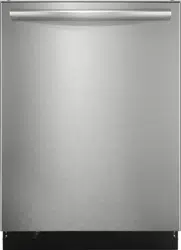Loading ...
Loading ...
Loading ...

21SAVING ENERGY
Energy use
The yellow energy guide label that came
on your unit tells how much energy
it would use in one year and how it
compares to others that are available.
The energy is based on the NORMAL
cycle response to tests that apply soils
and dishware that simulate the average
use. Eight place settings of dishware and
some serving pieces are used during the
test. The total energy is based on running
the average number of cycles per year,
applying typical soil levels to the dishware
and half the time, selecting the option of
using extra energy to more fully dry the
dishware. Actual energy and water use will
depend upon the cycle and options you
select.
This unit uses an in-line water heating
element that is located under the
tub. There is no exposed heater that
plasticware might come in contact with
or that is accessible to touch. The heat is
taken to the dishware through the heated
water. For this reason, plastic dishware
may be placed where it best fits in either
the top or bottom rack. Temperatures are
uniform throughout the dishwasher.
If the user prefers to save energy and
dry the dishes by hand they select
the AIR DRY option.
If you prefer to
spend slightly more energy to get the
dishes drier select one of the heated
dry options. In response the wash and
rinse temperatures in the cycle will be
increased.
This aids cleaning and also heats the
dishwasher. When all standing water is
removed in the final drain, the extra heat
stored in the dishware acts to evaporate
the remaining water.
In general, more energy is used when
more water and heat are used in a cycle.
Several cycles, such as the NORMAL
cycle, change based on soil level, options
selected, and ambient conditions. The
NORMAL cycle is good for all around use.
Other cycles are focused toward special
use like the H E AVY cycle that is designed
for heavily solid cookware.
Your unit has DishSense
TM
Technology
that works to sense how heavily
soiled the dish load is so the cycle is
automatically adjusted to the appropriate
response. This helps to prevent energy
waste. The sensor is calibrated at the end
of each cycle. and assures a clean load.
DishSense
TM
technology
NOTE
For the first cycle after power is applied
(when first installed or after a power
failure) the sensor will not be calibrated
and so cannot determine the soil load.
Therefore, the unit provides a response
suitable for heavily soiled dishes on the
first run after power is restored. Energy
use during this first run may be higher
than would be typical.
Loading ...
Loading ...
Loading ...
